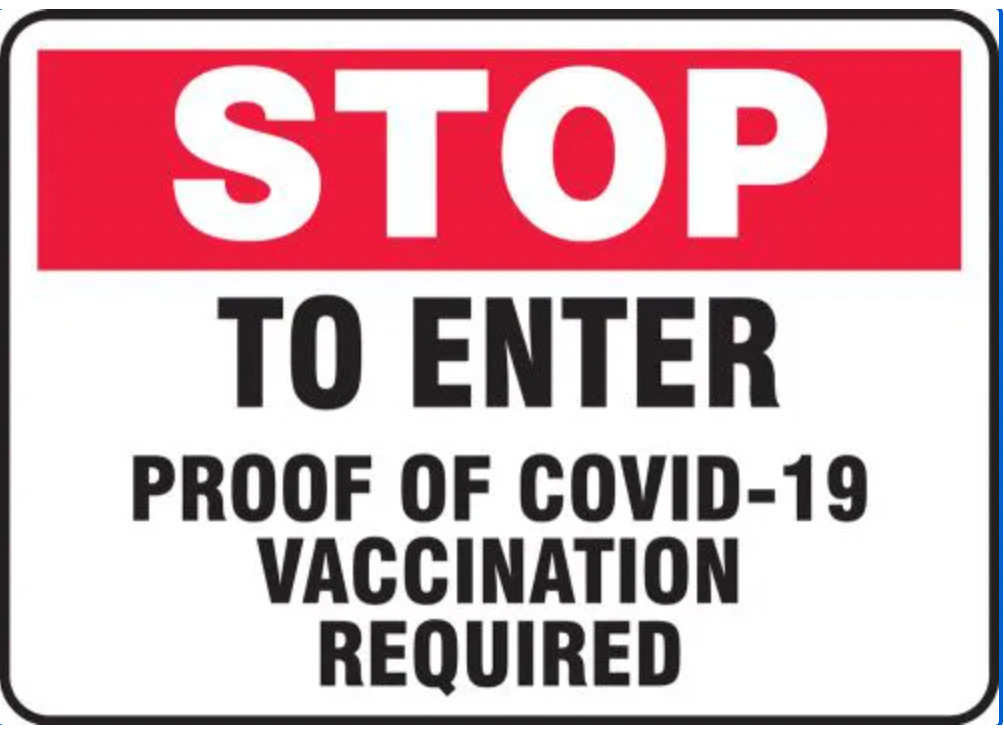In the Fog of COVID-19
Part 1: How vaccine mandates and proof policies stoked divisions and may prove to be both counterproductive and damaging to public health
In early winter of 2021, after the Nova Scotia proof of vaccine policy was put in place—barring unvaccinated people from accessing non-essential services such as restaurants, gyms, and cultural activities—I was told about an incident that took place at a nearby hospital. An individual had gone to get a scheduled ultrasound and when he was asked to reveal his vaccination status at the main desk, a public shaming ensued. Both the receptionist and another person waiting took it upon themselves to chastise the individual for his unvaccinated status. While the person was able to access the diagnostic procedure—since health care is deemed essential—the experience was a crushing one.
I relayed this story to the province’s Chief Medical Officer of Health at the December 7 COVID-briefing. For most of the pandemic, whether it had to do with mask-wearing or gathering limits, Dr. Robert Strang urged Nova Scotians not to succumb to their baser instincts. The hospital story seemed to bother him.
I asked: “The proof of vaccine policy and vaccine mandates have led to a worrying stigmatization, vilification, and segregation of a segment of the Nova Scotia population. . . And these policies are having ugly societal consequences. Have you considered they could be doing more societal harm than good?”
Strang replied: “I continue to ask that people, regardless of the choice they make, are treated with care and kindness.” But he went on to justify the policy, saying, “being unvaccinated puts other people at risk and what are the consequences of that?”
At that point in the pandemic, before the OMICRON variant had appeared on the scene, we knew that vaccine efficacy was already waning, and that fully vaccinated individuals with DELTA breakthrough infections could efficiently transmit the virus, including to fully vaccinated contacts. It seemed like a stretch to make the claim that mandates and proof policies that exclude the unvaccinated were creating anything close to virus-free spaces.
But Strang’s reply seemed to be pointing to a different rationale: that being vaccinated reduces your chances of ending up in hospital. “I think, if you flip it around and look at the impacts on all of us as a result of people who choose not to be vaccinated…then the choice to become vaccinated becomes very clear.”
Strang continued:
What we do know, and I’ve said it many times, the vaccines are not 100%, there are some people who get breakthrough cases, and may be able to spread it to others, but we know clearly with Canadian data that if your unvaccinated you’re 8X more likely to become infected; if you’re unvaccinated you’re about 28 times more likely to end up in hospital; and if you’re 18 to 50 you’re about 45 times more likely to end up in hospital; vaccines work, not just to protect individuals, they protect each other, and having high levels of vaccination protect our health care system.
Strang presented some pretty compelling comparisons, but were these telling the whole story?
Dr. Robert Strang, Nova Scotia’s Chief Medical Officer of Health
There are three points I want to address here.
The first involves how the rationale for vaccination shifted over time. When vaccines first became available, protecting the most vulnerable was the priority. Then, as eligibility expanded to younger and younger age groups, the goal was to reach a vaccination threshold that would “end the pandemic” and allow us to “get back to normal.” But once thresholds were reached—in Nova Scotia it was 75%—the rationale shifted again, this time to universal vaccination to “reduce hospital and ICU burden” because of the “pandemic of the unvaccinated.”
But what if the real culprit was waning vaccine efficacy coupled with new variants that evaded vaccine-acquired immunity? Who could we blame for that? And what about a health care system that had been overwhelmed for years, a result of underfunding and cutbacks? Maybe scapegoating the unvaccinated was politically expedient and deflected attention away from the real issues at hand.
The second point I want to make is that reporting health outcomes by vaccination status alone is not very meaningful. Furthermore, if it’s presented in a way that suggests causation then it’s also misleading. There are many other factors that influence whether someone infected with SARS-CoV-2 ends up in hospital. Vaccination status alone—which is how the government has been reporting the data—tells us something but not everything.
When I asked the Nova Scotia Department of Health and Wellness about this they responded:
There are many factors that contribute to health outcomes in individuals, ranging from age and pre-existing medical conditions, living conditions, working conditions, socioeconomic status and more. An individual’s vaccine status will impact their risk of developing COVID-19.
What if the unvaccinated also tended to be those in lower socio-economic groups with higher incidences of chronic disease? What if they tend to have those co-morbidities that everyone’s been talking about? What if they happen to be elderly people whose health was too frail to be vaccinated in the first place? What if they happen to be members of minority groups who are already suffering from social exclusion and discrimination? How could it ever be justified to bring in policies that further marginalize them?
The third point I want to address involves a very slippery slope. Here’s how this argument tends to be made, and I think Strang was trying to make it:
On February 25th—a date chosen for illustration purposes only—roughly 20.5% of those hospitalized in Nova Scotia because of COVID-19 were unvaccinated, compared to 2.3% who were partially vaccinated, 43% who were fully vaccinated, and 34% who had received a booster dose. Given that less than 10% of the Nova Scotia population were unvaccinated at the time, the unvaccinated—who made up 20.5% of those hospitalized due to COVID-19—were over-represented in the hospital system. Therefore, the way the argument goes, the burden on the health care system disproportionately fell on this group’s shoulders.
Using the metric of over-representation in the hospital system to decide who should be targeted in Canada for punitive measures, or blamed for overwhelming the health care system, is a road we just ought not go down. The obvious reason is that doing so would be highly unethical. But it also ignores underlying causes of illness. Health is very strongly affected by social determinants (listed below) and if health inequities exist—that is, if some groups are over-represented in the hospital system—it’s likely because of the social and economic inequities that exist. Let’s address those.
Stoking divisions
One could be forgiven if vaccine passports and proof policies feel decidedly un-Canadian. Prior to his own about-face, Prime Minister Justin Trudeau stated in May 2021, “We’re not a country that makes vaccination mandatory.” Around the same time, the scientific justification, legality, and ethics of such a move were being analyzed by civil liberties experts, as well as Canada’s privacy commissioners. In a joint statement about vaccine passports, they stated that in order for them to be justified, they must be necessary to achieve their intended public health purposes and they also had to be continually monitored to ensure they continue to be justified.
But by the end of December—after bringing in both vaccine passports for air and train travel as well as vaccine mandates for federal employees—Trudeau’s pivot turned ugly. In an interview that appeared on the Quebec talk show “La Semaine des 4 Julie,” where “anything is possible,” Trudeau referred to the unvaccinated as “racists,” “misogynists,” and “anti-science” and wondered aloud, “do we tolerate these people?” His about-face sowed deep divisions, and was, quite frankly, deeply disturbing.
It should be noted here that Canada is the only country in the Global North that has barred unvaccinated people from travel by air or train. This, despite the fact that the percentage of those who were exposed to COVID-19 as a result of travel outside Canada, or from contact with a traveller is estimated to be exceedingly small—0.8% and 0.5% respectively.[1] As well, according to Transport Canada, the risk of being infected while on an airplane is “considered to be low.”
“Freedom Convoy” converges on downtown Ottawa, January 28, 2022. Wiki commons.
Whether it was fuelled by Trudeau’s comments is up for grabs, but in the weeks following them, the anger and frustration over vaccine mandates and nearly two years of pandemic restrictions bubbled to the surface, and on January 28th the “Freedom Convoy” converged in downtown Ottawa. There were also a number of border blockades at the Ambassador Bridge between Windsor and Detroit, as well as at Coutts, Alberta, and Emerson, Manitoba. Numerous other smaller protests erupted spontaneously across the country over a wide range of pandemic grievances including the divisive vaccine policies. In response, Trudeau invoked the Emergencies Act, which allowed the government to use extraordinary measures including financial tools like de-banking to end what was being called a “siege” of the capital and a “nation-wide insurrection.”
In the days and weeks following the historic “blockade” or “siege”—depending on how you look at it—provinces began lifting restrictions, including vaccine proof policies.
On February 23rd, Premier Tim Houston announced that on March 1st, roughly five months after it was put in place, the proof of vaccine policy would end for Nova Scotia. Without explicitly naming the policy itself as the source of the worrying divisions, Houston said the following:
We live in increasingly divided communities and sadly, some personal relationships have been broken beyond repair in the last two years, but certainly in the last few months. We have to stop viciously attacking those with different opinions and remember we are all on the same team. . . There comes a point in time when the benefit of the restrictions is outweighed by the impact of those restrictions, particularly on our children, on our seniors, and on our collective mental wellbeing. We’ve reached that point. . . We will see the removal of the proof of vaccine. . . [It] has served its purpose. It has served Nova Scotians well, but it was only ever meant as a temporary measure and its time has come.
Nova Scotia Premier Tim Houston, COVID-19 Update, February 23, 2022
According to Houston, the proof of vaccine policy “has served Nova Scotians well.”
But did it?
A recent preprint study calls Houston’s claim into serious question. It hypothesizes that these punitive measures, which were implemented in tandem all over the world, turned out to be counterproductive, causing damage to public health, rather than the other way around.
Stay tuned for Part 2 of this two-part series, which will feature a wide-ranging interview with Kevin Bardosh, who is an applied medical anthropologist currently with the School of Public Health at the University of Washington.
[1] Scroll down to “How people were exposed” on the Health Info-database for Canada. POSTSCRIPT: This page can no longer be found, but a June, 2022 version is “archived” on the internet here: https://health-infobase.canada.ca/covid-19/archive/2022-06-10/#a6









Excellent journalism. Well researched and succinct!
please will you cover my story i have had a serious reaction to the needle in nova scotia i was told i was not having anything wrong and that i am mental and was refused medical attention nova scotia my heart has not been normal ever since please cover my story